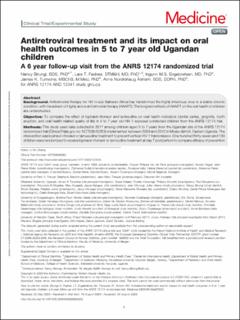Antiretroviral treatment and its impact on oral health outcomes in 5 to 7 year old Ugandan children A 6 year follow-up visit from the ANRS 12174 randomized trial
Birungi, Nancy; Fadnes, Lars T.; Engebretsen, Ingunn M.S.; Tumwine, James K.; Åstrøm, Anne Nordrehaug
Journal article, Peer reviewed
Published version

Åpne
Permanent lenke
https://hdl.handle.net/11250/2727685Utgivelsesdato
2020-09-25Metadata
Vis full innførselSamlinger
- Department of Clinical Dentistry [479]
- Registrations from Cristin [10412]
Sammendrag
Background: Antiretroviral therapy for HIV in sub-Saharan Africa has transformed the highly infectious virus to a stable chronic
condition, with the advent of Highly active antiretroviral therapy (HAART). The longterm effects of HAART on the oral health of children
are understudied.
Objective: To compare the effect of lopinavir-ritonavir and lamivudine on oral health indicators (dental caries, gingivitis, tooth
eruption, and oral health related quality of life) in 5 to 7 year old HIV-1 exposed uninfected children from the ANRS 12174 trial.
Methods: This study used data collected in 2017 among children aged 5 to 7 years from the Ugandan site of the ANRS 12174
randomized trial (ClinicalTrials.gov no: NCT00640263) implemented between 2009 and 2012 in Mbale district, Eastern Uganda. The
intervention was lopinavir-ritonavir or lamuvudine treatment to prevent vertical HIV-1 transmission. One hundred thirty-seven and 139
children were randomized to receive lopinavir-ritonavir or lamivudine treatment at day 7 postpartum to compare efficacy of prevention
